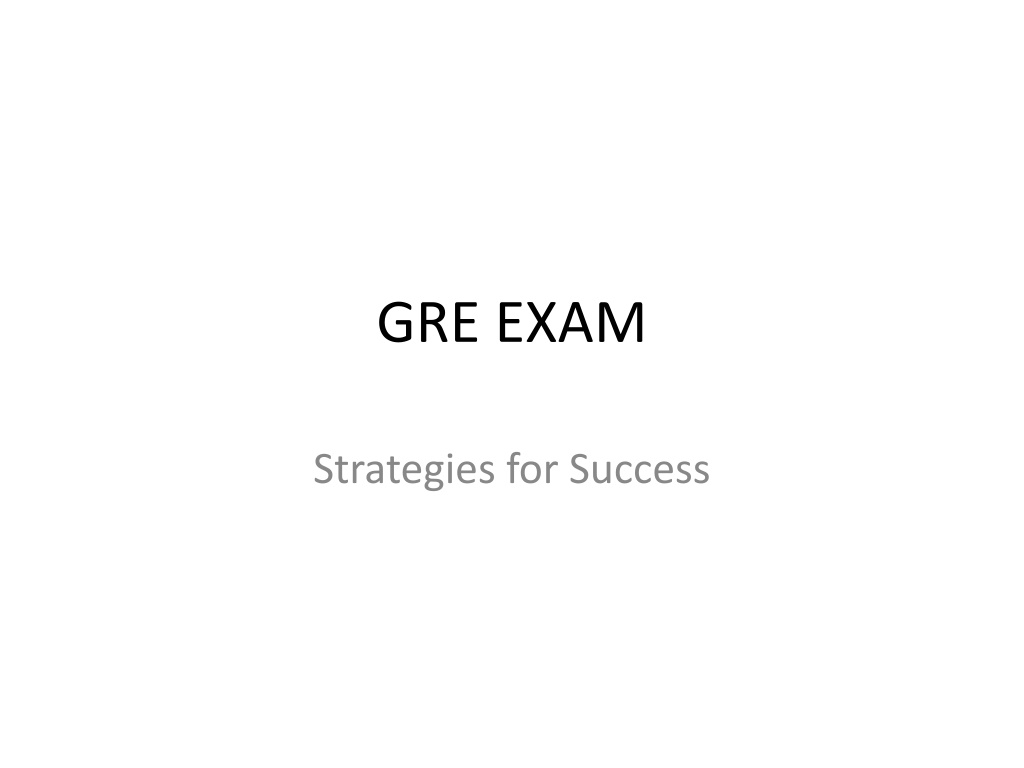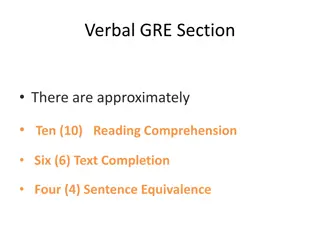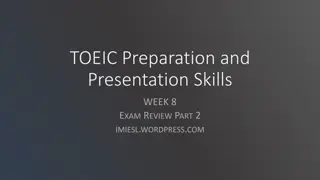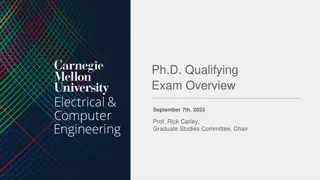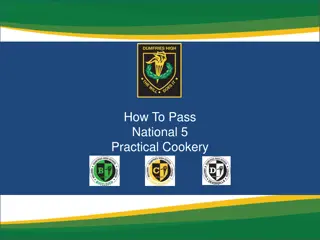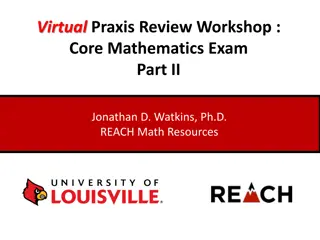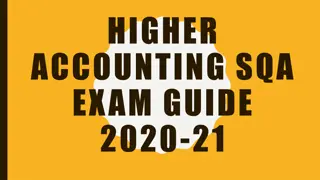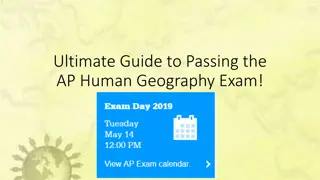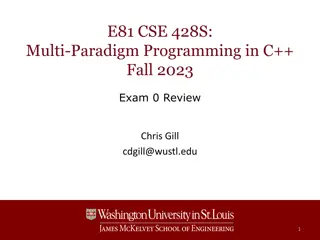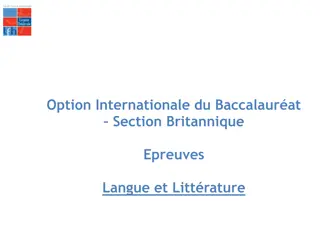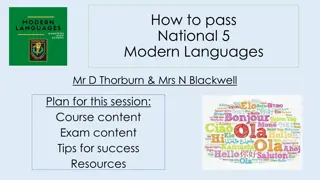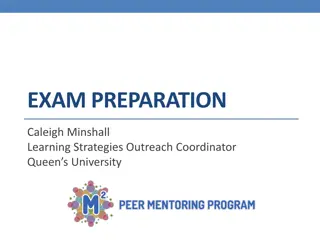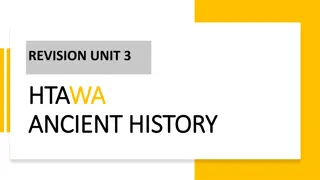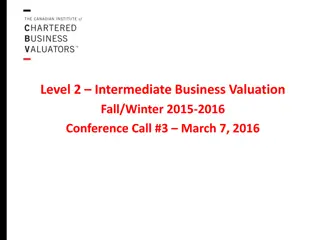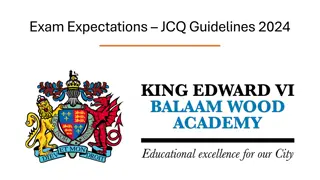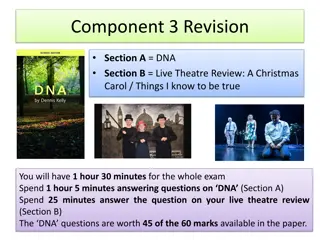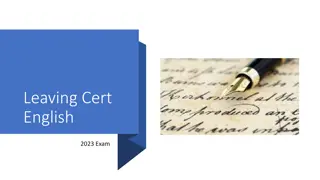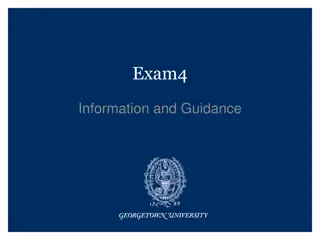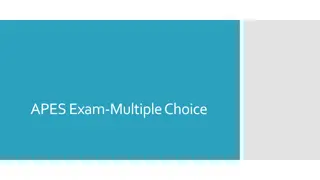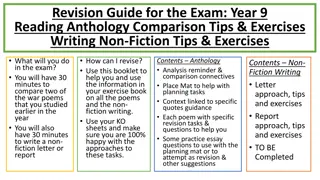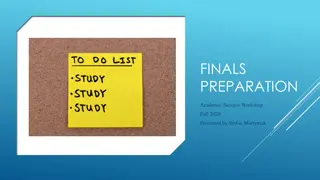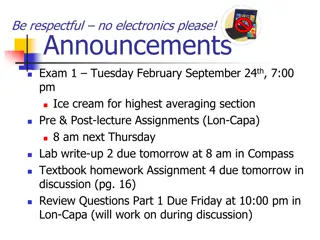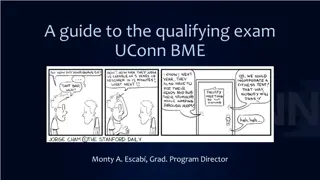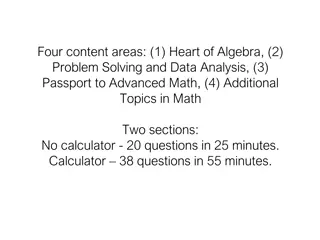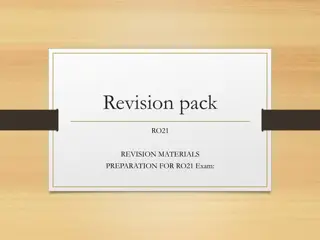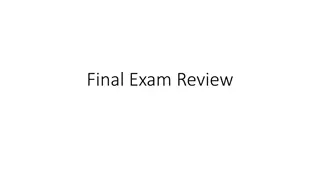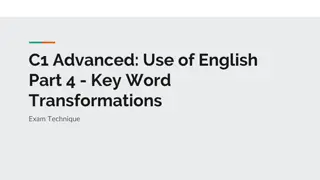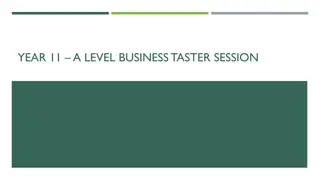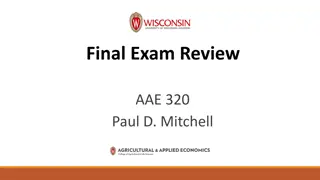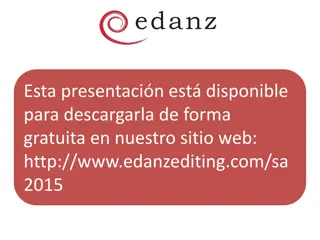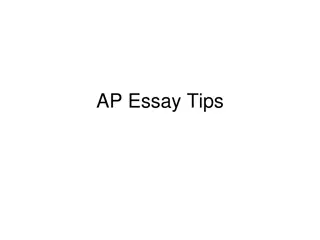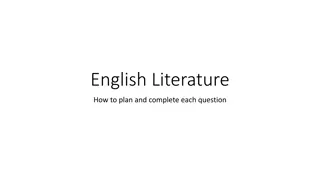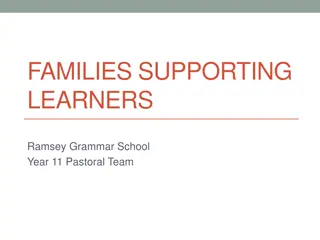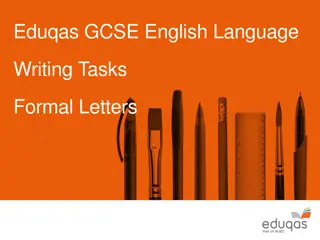Mastering GRE Exam: Strategies, Structure, and Success Tips
Comprehensive guide to succeeding in the GRE exam, covering test structure, timing, scoring, and key strategies for Analytical Writing, Verbal Reasoning, and Quantitative Reasoning sections. Learn about the adaptive nature of the test, available tools, and new answer formats for effective preparation. Get insights into the scoring system and essential tips for Reading Comprehension questions.
Download Presentation

Please find below an Image/Link to download the presentation.
The content on the website is provided AS IS for your information and personal use only. It may not be sold, licensed, or shared on other websites without obtaining consent from the author. Download presentation by click this link. If you encounter any issues during the download, it is possible that the publisher has removed the file from their server.
E N D
Presentation Transcript
GRE EXAM Strategies for Success
GRE EXAM Structure of the Computer-Based Test Analytical Writing: one section with two essays 30 minutes per essay; one hour total Analyze an Issue Analyze an Argument
Structure of the Computer-Based Test Analytical Writing: one section with two essays Verbal Reasoning: two sections Approximately 20 questions per section 30 minutes per section
Structure of the Computer-Based Test Analytical Writing: one section with two essays Verbal Reasoning: two sections Quantitative Reasoning: two sections Approximately 20 questions 35 minutes per section
Structure of the Computer-Based Test Analytical Writing: one section with two essays Verbal Reasoning: two sections Quantitative Reasoning: two sections Unscored (varies) Research (varies)
Structure of the Computer-Based Test Summary: One 60-minute essay-writing session. Plus five 30-or-35-minute multiple-choice sections (only four sections count towards your score). Total testing time of 3 hours 45 minutes, plus breaks, etc.
GRE Test Design Features You may move forward and backward throughout any section Mark and Review feature You may change or edit answers within a section Scoring is Section-level adaptive On-screen calculator for Quantitative Reasoning New answer formats
GRE Test Scoring Analytical Writing: score between 0 6; schools receive a copy of the two essays Verbal Reasoning: scaled score between 130 170 (mean 150) Quantitative Reasoning: scaled score between 130 170 (mean 150)
Reading Comprehension Introduction HALF of the Verbal Reasoning questions are Reading Comprehension (10 out of 20) About 6 9 passages; about 50 300 words; many are one paragraph, but some might be as long as five paragraphs Expect 1 4 questions per passage Passages from physical sciences, biological sciences, social sciences, arts and humanities, everyday topics
Reading Comprehension Format The passage appears here, across the top of the page. The passage will remain on the screen until you have answered all questions. The first question related to this passage is HERE, across the middle of the page The answer choices are located HERE, near the bottom of the screen.
Reading Comp. Attack Strategy 1st PRE-READ the question 2nd READ the passage 3rd RE-READ the question carefully 4th ANALYZE the answer choices, eliminating wrong ones as you read
Strategies for Effective Reading 1. Read the passage ONCE. Avoid rereading at this time; get the content and overall point. How do I accomplish that?
Strategies for Effective Reading 1. Read the passage ONCE. Avoid rereading at this time; get the content, the author s point(s). READ ACTIVELY
Strategies for Effective Reading 1. Read the passage ONCE. Avoid rereading at this time; get the content, the author s point(s). READ ACTIVELY VISUALIZE
Strategies for Effective Reading 1. Read the passage ONCE. Avoid rereading at this time; get the content, the author s point(s). READ ACTIVELY VISUALLY PARAPHRASE
Strategies for Effective Reading 1. Read the passage ONCE. Avoid rereading at this time; get the content, the author s point(s). READ ACTIVELY VISUALLY PARAPHRASE ANALYZE
Strategies for Insightful Analysis Distinguish main idea from supporting ideas. Distinguish author s personal ideas from mere reporting. Distinguish hypothetical or speculative ideas from author s committed ideas. Identify transitions from one idea to another. Identify the relationship between different ideas.
Strategies for R.C. Questions 1. Read the passage ONCE. 2. Do not apply outside knowledge to either the question or the passage.
Strategies for R.C. Questions 1. Read the passage ONCE. 2. Do not apply outside knowledge. 3. Read the questions carefully. Many wrong answers stem from misreading the question; know what is being asked.
Strategies for R.C. Questions 1. Read the passage ONCE. 2. Do not apply outside knowledge. 3. Read the questions carefully. Many wrong answers stem from misreading the question; know what is being asked. 4. Read each answer choice carefully; ONLY use the information in the passage.
Reading Comprehension Question Formats Select Only One Answer Choice
Select Only One Answer: format This is the most common set-up, the one you are most familiar with: one question, five answer choices. Most Reading Comprehension questions follow this format.
Select Only One Answer: format The passage appears here, across the top of the page. The question will be printed here. Sample: The author would agree with which of the following? The answer choices appear here. o Choice #1 o Choice #2 o Choice #3 o Choice #4 o Choice #5 Simply click on the one correct choice.
Select Only One Answer: Strategies Read ALL five of the answer choices; eliminate wrong ones as you go. Be sure to read the question carefully. Correct response = most accurately and completely answers the specific question. When asked about vocabulary, use passage context and content.
Sample Questions 1 3 are based on the following passage: Roses are red. Violets are blue. Sugar is sweet. And so are you.
Roses are red. Violets are blue. Sugar is sweet. And so are you. Sample Reading Comprehension Question #1 Five Options, Select Only One #1. According to the passage, what color are roses? o Blue. o Green. o Yellow. o Red. o Sweet. Answer: The 4th Option: Roses are red.
Reading Comprehension Question Formats Select Only One Answer Choice Select One or More Answer Choices
Select One or More Questions These questions mimic the old multiple- multiple choice questions, the ones you loved to hate! They were frustrating and time consuming.
Select One or More: old format The multiple-multiple choice old format had a question here, followed by three options: I. First potential option II. Second potential option III. Third potential option Then, you had to choose from five answers. A. I only B. II only C. I and III only D. II and III only E. I, II, and III
Select One or More: new format The passage appears here, across the top of the page. The directions will read For the following question, consider each choice separately and select all that apply. The author suggests that is true in which of the following respects? First potential option. Second potential option. Third potential option. You simply click on each correct option. Viola!
Select One or More Answer Strategies Three choices; select ALL correct responses for credit. No partial credit. Evaluate each answer option independently. Correct response(s) most accurately and completely answer the question. All three answers may be correct; do not be misled.
Roses are red. Violets are blue. Sugar is sweet. And so are you. Sample Reading Comprehension Question #2 Three Options, Select All Correct Choices Consider each of the three choices separately and select all that apply. #2. Based on the facts presented in the passage, which of the following must be true? Roses are red. Blue was the color of all the Violets that were included in this sample. If any substance is sweet, it must be sugar. Answer: The first two options are both true; Roses are red and Violets are blue. However, the 3rd Option is false; the passage states that sugar is sweet, but it does not state the inverse, that all sweet things are sugar.
Reading Comprehension Question Formats Select Only One Answer Choice Select One or More Answer Choices Select-In-Passage
Select-In-Passage Questions These questions mimic the old our answer choices will repeat five quotations from the text and you choose the one that answers our question. This format was very time consuming.
Select-In-Passage: old format A question would be printed here, such as Which of the following best clarifies the author s point about . Followed by five answer choices, all quotations from the text. You chose the one that best answered the question. A. .. B. .. C. .. D. .. E. ..
Select-In-Passage: new format The passage appears here, across the top of the page. The question will read Select a sentence in the passage that . The author suggests that is true in which of the following respects? First potential option. Second potential option. Third potential option. You simply click on each correct option. Viola!
Select-In-Passage: Strategies Select the one sentence that best answers the question; placing the cursor anywhere in sentence will highlight it. Evaluate each of the relevant sentences in the designated paragraph. Correct sentence = most accurately matches the task in the question.
Roses are red. Violets are blue. Sugar is sweet. And so are you. Sample RC Question #3: Select-In-Passage Question: #3. Select the sentence in the passage that identifies the flavor sensation caused by the presence of sugar.
Roses are red. Violets are blue. Sugar is sweet. And so are you. Sample Select-In-Passage Question: #3. Select the sentence in the passage that identifies the flavor sensation caused by the presence of sugar. Answer: The correct answer is line 3, Sugar is sweet.
Reading Comprehension Question Categories 1. Main Idea
Reading Comprehension Question Categories 1. Main Idea 2. Supporting Idea
Reading Comprehension Question Categories 1. Main Idea 2. Supporting Idea 3. Implications / Inferences
Reading Comprehension Question Accessibility Know how to access the accurate answer; questions are written in three levels: FACTUAL QUESTIONS
Reading Comprehension Question Accessibility Know how to access the accurate answer; questions are written in three levels: FACTUAL QUESTIONS MAIN IDEA QUESTIONS
Reading Comprehension Question Accessibility Know how to access the accurate answer; questions are written in three levels: FACTUAL QUESTIONS MAIN IDEA QUESTIONS HIDDEN IDEA QUESTIONS
Reading Comprehension Eliminating Wrong Answers To eliminate incorrect answer choices, look for: KEY: Key words misstated or key ideas twisted (contradicts passage)
Reading Comprehension Eliminating Wrong Answers To eliminate incorrect answer choices, look for: KEY: Key words misstated or key ideas twisted Reversals: Answer leads in opposite direction (e.g. weakening instead of strengthening)
Reading Comprehension Eliminating Wrong Answers To eliminate incorrect answer choices, look for: KEY: Key words misstated or key ideas twisted Reversals: Answer leads in opposite direction N/A: Answer brings up info that is not addressed (i.e. answer has outside information)
Reading Comprehension Eliminating Wrong Answers To eliminate incorrect answer choices, look for: KEY: Key words misstated or key ideas twisted Reversals: Answer leads in opposite direction N/A: Answer brings up info that is not addressed Irr.: Answer is irrelevant to this question (answer may be true, but not for this question)
Reading Comprehension Eliminating Wrong Answers To eliminate incorrect answer choices, look for: KEY: Key words misstated or key ideas twisted Reversals: Answer leads in opposite direction N/A: Answer brings up info that is not addressed Irr.: Answer is irrelevant to this question Too General/Too Specific: Answer not the right size
